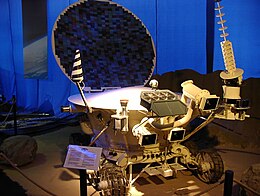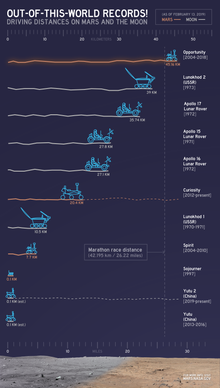Lunokhod 2
 Model of 'Lunokhod 2 rover | |
| Mission type | Lunar rover |
|---|---|
| COSPAR ID | 1973-001A |
| Spacecraft properties | |
| Dry mass | 840 kilograms (1,850 lb) (rover only) |
| Start of mission | |
| Launch date | January 11, 1973, 06:55:38 UTC |
| Rocket | Proton-K/D |
| Launch site | Baikonur 81/23 |
| End of mission | |
| Last contact | May 11, 1973 |
| Lunar rover | |
| Spacecraft component | Rover |
| Landing date | January 15, 1973 |
Lunokhod 2 (Template:Lang-ru ("Moonwalker 2"), also known as Аппарат 8ЕЛ № 204 ("Device 8EL No. 204")) was the second of two unmanned lunar rovers landed on the Moon by the Soviet Union as part of the Lunokhod programme.
The Luna 21 spacecraft landed on the Moon and deployed the second Soviet lunar rover, Lunokhod 2, in January 1973.[1][2][3] The primary objectives of the mission were to collect images of the lunar surface, examine ambient light levels to determine the feasibility of astronomical observations from the Moon, perform laser ranging experiments from Earth, observe solar X-rays, measure local magnetic fields, and study the soil mechanics of the lunar surface material.
Lunokhod 2 rover and subsystems

The rover stood 135 centimetres (4 feet 5 inches) high and had a mass of 840 kg (1,850 lb). It was about 170 centimetres (5 feet 7 inches) long and 160 centimetres (5 feet 3 inches) wide and had eight wheels each with an independent suspension, electric motor and brake. The rover had two speeds, about 1 and 2 km/h (0.62 and 1.24 mph). Lunokhod 2 was equipped with three television cameras, one mounted high on the rover for navigation, which could return high resolution images at different frame rates—3.2, 5.7, 10.9 or 21.1 seconds per frame. These images were used by a five-man team of controllers on Earth who sent driving commands to the rover in real time. Power was supplied by a solar panel on the inside of a round hinged lid which covered the instrument bay, which would charge the batteries when opened. A polonium-210 radioisotope heater unit was used to keep the rover warm during the long lunar nights. There were four panoramic cameras mounted on the rover. Scientific instruments included a soil mechanics tester, solar X-ray experiment, an astrophotometer to measure visible and ultraviolet light levels, a magnetometer deployed in front of the rover on the end of a 2.5 m (8 ft 2 in) boom, a radiometer, a photodetector (Rubin-1) for laser detection experiments, and a French-supplied laser corner reflector. The lander carried a bas relief of Vladimir Lenin and the State Emblem of the Soviet Union. The lander and rover together massed 1814 kg.
Mission
The Proton-K/D launcher put the spacecraft into Earth parking orbit followed by translunar injection. On January 12, 1973 Luna 21 was braked into a 90 by 100 km (56 by 62 mi) lunar orbit. On January 13 and 14, the perilune was lowered to 16 km (9.9 mi) altitude.
Landing and surface operations
On January 15 after 40 orbits, the braking rocket was fired at 16 km (9.9 mi) altitude, and the craft began to de-orbit. At an altitude of 750 m (2,460 ft) the main thrusters began firing, slowing the fall until a height of 22 m (72 ft) was reached. At this point the main thrusters shut down and the secondary thrusters ignited, slowing the fall until the lander was 1.5 m (4.9 ft) above the surface, where the engine was switched off. Landing occurred at 23:35 UT in Le Monnier crater at 25.85 degrees N, 30.45 degrees E.
After landing, the Lunokhod 2 took TV images of the surrounding area, then rolled down a ramp to the surface at 01:14 UT on January 16 and took pictures of the Luna 21 lander and landing site, driving for 30 metres. After a period of charging up its batteries, it took more pictures of the site and the lander, and then set off to explore the moon.
The rover would run during the lunar day, stopping occasionally to recharge its batteries with the solar panels. At night the rover hibernated until the next sunrise, heated by the radioactive source.
- January 18, 1973 to January 24, 1973: The rover drives 1,260 metres
- February 8 to 23: The rover drives 9,086 metres further
- March 11 to 23: The rover drives 16,533 metres further
- April 9 to 22: The rover drives 8,600 metres further
- May 8 to June 3: The rover drives 880 metres further

End of mission
On June 4, 1973 it was announced that the program was completed, leading to speculation that the vehicle probably failed in mid-May or could not be revived after the lunar night of May–June.
More recently, Alexander Basilevsky related an account in which on May 9, the rover's open lid touched a crater wall and became covered with dust. When the lid was closed, this dust (a very good insulator) was dumped on to the radiators. The following day, May 10, controllers saw the internal temperature of Lunokhod 2 climb as it was unable to cool itself, eventually rendering the rover inoperable.[4] On May 11, signal from the rover was lost.
Results

Lunokhod 2 operated for about four months, and the original estimate was that it covered 37 km (23 mi) of terrain, including hilly upland areas and rilles, and sent back 86 panoramic images and over 80,000 TV pictures.[4][5][6] Many mechanical tests of the surface, laser ranging measurements, and other experiments were completed during this time. Lunokhod 2 was thought to have covered 37 km (23 mi) based on wheel rotations but Russian scientists at the Moscow State University of Geodesy and Cartography (MIIGAiK) revised that to an estimated distance of about 42.1–42.2 km (26.2–26.2 mi) based on Lunar Reconnaissance Orbiter (LRO) images of the lunar surface.[7][8] Subsequent discussions with their American counterparts ended with an agreed-upon final distance of 39 km (24 mi);[9][10] an international team has confirmed that the methods used to calculate the two rovers' odometry is consistent and comparable from the Moon to Mars.[11]
Lunokhod 2 held the record for off-Earth roving distance until July 27, 2014, when NASA's Mars Opportunity rover exceeded it after having traveled over 40 km (25 mi).[12][13]
Current status

Lunokhod 2 continues to be detected by lunar laser ranging experiments and its position is known to sub-meter accuracy.[15] On March 17, 2010 Phil Stooke at the University of Western Ontario announced that he had located Lunokhod 2 in NASA Lunar Reconnaissance Orbiter (LRO) images,[16][17][18] but later images showed the initial identification was incorrect (the identified point was a mark in the rover tracks near the end of the route, made as Lunokhod 2 turned around), and the LRO LROC team identified the correct location of the rover in March 2012.[5][19] Excellent Lunokhod 2 images from LROC were published by Mark Robinson on SESE site of ASU.[20]
Present ownership
Ownership of Lunokhod 2 and the Luna 21 lander was sold by the Lavochkin Association for $68,500 in December 1993 at a Sotheby's auction in New York.[18][21] (The catalog[22] incorrectly lists lot 68A as Luna 17/Lunokhod 1).
The buyer was computer gaming entrepreneur and space tourist Richard Garriott (son of the astronaut Owen K. Garriott), who stated in a 2001 interview with Computer Games Magazine's Cindy Yans that:
- I purchased Lunakod 21 [sic] from the Russians. I am now the world's only private owner of an object on a foreign celestial body. Though there are international treaties that say, no government shall lay claim to geography off planet earth, I am not a government. Summarily, I claim the moon in the name of Lord British![23]
Garriott later confirmed that he is the owner of Lunokhod 2.[18][24][25]
See also
- Exploration of the Moon
- Lunar rover
- Lunokhod 1
- Rover (space exploration)
- Timeline of artificial satellites and space probes
- List of artificial objects on the Moon
References
- ^ Lunokhod 02, NASA Solar System Exploration; page updated March 15, 2018. Retrieved May 31, 2018.
- ^ NSSDC Catalog, Luna 21/Lunokhod 2, version March 21, 2017. Retrieved May 31, 2018.
- ^ Mulholland, J. D.; Shelus, P. J.; Silverburg, E. C. (January 1, 1975). "Laser observations of the moon: Normal points for 1973". NASA. NTRS. Retrieved June 17, 2011.
- ^ a b Andrew Chaikin (March 1, 2004). "The Other Moon Landings". Air & Space/Smithsonian. Retrieved May 25, 2013.
- ^ a b Lewis Page (March 16, 2012). "New NASA snap of game developer's electric cart FOUND ON MOON: Probe in low pass over Garriott's radioactive tub-rover". The Register. Retrieved May 25, 2013.
- ^ "Lunokhod 2 Revisited". NASA. March 13, 2012. Retrieved May 25, 2013.
- ^ Lakdawalla, Emily (June 21, 2013). "Is Opportunity near Lunokhod's distance record? Not as close as we used to think!". The Planetary Society. Retrieved June 26, 2013.
- ^ Witze, Alexandra (June 19, 2013). "Space rovers in record race". Nature News. Retrieved June 26, 2013.
- ^ Sutherland, Scott (July 29, 2014) It's Official! NASA confirms Mars Opportunity rover has broken the off-world driving record. theweathernetwork.com
- ^ Robinson, Mark (May 23, 2014) Trundling Across the Moon. sese.asu.edu
- ^ Wall, Mike (July 29, 2014) NASA's Mars rover Opportunity breaks off-world driving record. Space.com
- ^ Webster, Guy; Brown, Dwayne (July 28, 2014). "NASA Long-Lived Mars Opportunity Rover Sets Off-World Driving Record". NASA. Retrieved July 29, 2014.
- ^ Knapp, Alex (July 29, 2014). "NASA's Opportunity Rover Sets A Record For Off-World Driving". Forbes. Retrieved July 29, 2014.
- ^ Page, Lewis (March 17, 2010). "Game developer's lost electric buggy found on moon". The Register. Retrieved May 31, 2018.
- ^ "Lunar Geophysics, Geodesy, and Dynamics" (PDF). ilrs.gsfc.nasa.gov. Retrieved February 6, 2008.
- ^ "Russian Lunar Rover Found: 37-Year-Old Space Mystery Solved". Science Daily. Retrieved March 17, 2010.
- ^ David, Leonard (March 18, 2010). "NASA Lunar Orbiter Spots Old Soviet Moon Landers". Retrieved May 31, 2018. Space.com.
- ^ a b c Chang, Kenneth (March 20, 2010). "After 17 Years, a Glimpse of a Lunar Purchase". New York Times. Retrieved April 1, 2010.
Richard A. Garriott has finally seen the item he bought 17 years ago for $68,500.
- ^ NASA, LROC Coordinates of Robotic Spacecraft 2013, Update September 25, 2013. Retrieved May 31, 2018.
- ^ Mark Robinson, "Lunokhod 2 Revisited", LROC, SSE, Arizona State University. Retrieved May 31, 2018.
- ^ Kluger, Jeffrey (April 1994) The Bloc on the Block. Discover magazine
- ^ Sotheby's Catalogue – Russian Space History, Addendum, Lot 68A, December 11, 1993
- ^ Garriott, Richard (April 13, 2001) Lord British, we hardly knew ye. demiurg.net
- ^ The Astronaut's Son's Secret Sputnik. CollectSPACE. October 2007
- ^ Are We Alone Archived December 19, 2008, at the Wayback Machine. (podcast interview with SETI Institute Director Seth Shostak) December 10, 2007
External links
- Zarya – Lunokhod 2 chronology
- Don P. Mitchell's catalog of Soviet Moon Images including many from Lunokhod 2
- Lunokhod 2 information and VRML models at the Virtual Space Museum
- Lunokhod 2 panoramic images
- Lunokhod 2 in space museum – 360 degree panoramic image
- Lunokhod 2 traverse overview, Lunokhod 2's path in southern Le Monnier crater
